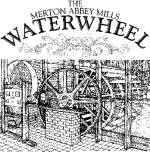The wheel has four sets of spoked rims and hubs, each one cast in a single piece. The casting of the frame is a masterpiece of the pattern makers art, as the octagonal hub carries seven crossshaped spokes. Each rim has 49 rectangular holes to carry the the wooden starts, which support the floats. The main shaft bearings are supported on a pair of brick columns, one on a small island and the other inside the wheelhouse. Contact Steve Llewellyn at the Wheelhouse at Merton Abbey Mills for this and other books, pamphlets and educational materials
| [Full size image 22.6kb] |
The primary gear is 3708mm diameter and has been cast in two halves. The 110 teeth on the primary gear engage with a secondary (or lay) gear which is 355mm in diameter and has 10 teeth. On the same shaft is an iron pulley 1828mm in diameter with a 304mm wide rim from which the machinery is driven by four belts.
When the brake (1) is released, the flow of the river turns the wheel rotating the main axle(2). Inside the wheelhouse the power is transferred from the primary gear (3) on the main axle through the laygear (4) to the flywheel (5). This in turn drives four belts powering a 12 volt generator (6) which charges the battery (1) i a heat pump compressor (8) ; a lathe, pillar drill and a potters wheel (not shown). Electrical switches and control gear are mounted on the main panel (9). The windlass (10) raises and lowers the sluice, which controls the flow of water under the waterwheel. A small pulley (11) on the main shaft drives an automatic lubrication system (12) .
